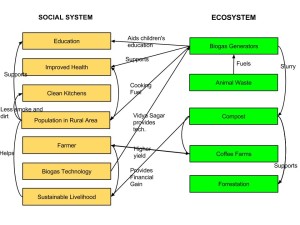This week’s assignment was inspired by a TED Talk that I recently watched, about Bhutan discussing the nation and climate change. Bhutan is a small country in Asia that has promised and is making the commitment to remain carbon neutral. The above diagram gives a few hints on how Bhutan, this small underdeveloped country is dedicated on remaining carbon negative. Please check out the video in the link below.
http://www.ted.com/talks/tshering_tobgay_this_country_isn_t_just_carbon_neutral_it_s_carbon_negative
As I watched this video, I was instantly captivated by Tobgay Tshering’s presentation about Bhutan. In this short twenty minute video, a great synopsis of Bhutan is clearly portrayed. Bhutan located on the Himalayas between India and China has a population of about 700,000. What was most fascinating about the TED Talk is that currently Bhutan has a holistic and balanced approach to development that is driven and maintained by the government. What is holistic development? It is right balance between equitable and sustainable livelihood, ecological conservation, good governance and a thriving culture. The Gross National Happiness, now a revolutionary initiative was proposed and implemented back in the seventies by Bhutan’s former emperor. GNH promotes harmony and connectedness with nature amongst the people. As a result, collectively as a nation Bhutan has kept its pristine forests that currently covers 72% of its land mass. In addition, the constitution has put into effect a policy which demands that 60% of Bhutan’s total land mass shall be maintained under forest cover. How does Bhutan manage to be carbon negative? The entire country generates about to 2.2 tons of CO2 which they offset is various ways. To begin with, they give free electricity to rural farmers, hence limit the use of firewood. The government invests in sustainable transportation by subsidizing the purchase of electric vehicles. Also subsidies of LED lights as well as programs that focus on planting trees and cleaning up the country are prevalent. Ultimately, it is the forest cover which absorbs about 6.8 million tons of CO2, thus making Bhutan carbon negative.
How does Bhutan compare with my hometown? One of the key drivers of Bhutan’s edge and success with commitments to making a difference in climate change comes down to leadership / governance. Bhutan’s innovative governance that began in the seventies has set the path that some nations recently began adopting, for which here in the US there is still some catching up to do. In my community, Falls Church, a Washington DC suburb, the Gross National Happiness or holistic development isn’t the government’s main focus. Neither is government / leadership steering widespread sustainability programs such as the standards supported in Bhutan. Campaigns like tree planting, sustainable development, regulating greenhouse gas emissions, pushing subsides for purchases of electric cars should be headed by government. Even so, sustainability is a collective action, therefore the communities and government need to come together to put into effect and accomplish these initiatives. There are some advancements towards sustainability and reducing carbon footprint that the Falls Church community could drive. Planting trees, preserving the little greenery that is left in the county and cleaning up the community are simple initiatives that can easily be jump started. Needless to say there are a few US cities that making strides towards sustainability, now it’s up to the rest of us to come together collectively and take action.



